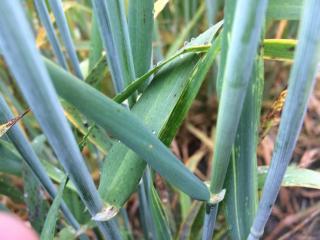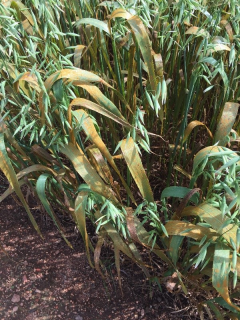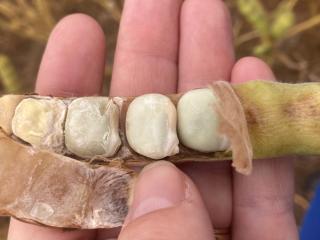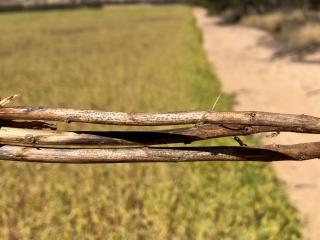Final PestFax newsletter for 2021!
This is the 21st and final issue of the PestFax newsletter for the 2021 growing season. Extra editions may be circulated if extraordinary circumstances occur after this time.
All of this season’s PestFax newsletters can be found at DPIRD’s PestFax newsletter archive.
2021 PestFax statistics
This year the PestFax team received nearly 2800 reports in total (current to 3 November 2021).
What were the top five reported pests?
The PestFax team received 1056 invertebrate pest reports. The native budworm was the most reported pest with 452 reports received via the spring trapping program and non-trapping reports. This was followed by the Australian plague locust (83) and diamondback moth (76). The top five insects reported are listed in Table 1, below.
| Insect | Number of reports |
|---|---|
| Native budworm- trapping and non-trapping reports | 452 |
| Australian plague locust | 83 |
| Diamondback moth | 76 |
| Russian wheat aphid | 71 |
| Green peach aphid | 60 |
What were the top five reported plant diseases for 2021?
As of 3 November 2021, there were nearly 500 plant disease reports recorded by the PestFax team from a variety of sources. Spot-type net blotch in barley was the most reported disease (72 reports), followed by Septoria nodorum blotch in wheat (56). Table 2, below, displays the other diseases that were most commonly reported.
| Disease | Number of reports |
|---|---|
| Spot-type net blotch of barley | 72 |
| Septoria nodorum blotch in wheat | 56 |
| Net-type net blotch of barley | 51 |
| Yellow spot in wheat | 35 |
| Blackleg in canola | 35 |
2021 PestFax map statistics
The PestFax map provides a visual display of the pests and diseases reported by the industry since 1996. Viewers can choose a host, a disorder and a time period. They can also select a 'Same time as last year' map view to highlight seasonal commonality or differences.
In 2021, an impressive 11 577 maps were generated as of 4 November. This number includes every map generated between each dropdown box selection.
Maps that displayed ‘All’ disorders were generated the most with 7928 generated.
Russian wheat aphid was the disorder map most specifically generated (936), followed by Australian plague locust maps (522). To see what the other top disorder maps viewed were refer to Table 3 below. These disorders may have been viewed for previous season’s distribution (historical data) as well as this season.
| Disorder | Number of maps generated |
|---|---|
| Russian wheat aphid | 936 |
| Australian plague locust | 522 |
| Sclerotinia stem rot | 291 |
| Mouse | 256 |
| Green peach aphid | 250 |
Acknowledgements
The PestFax team would like to say a big thank you to everyone who took the time to submit insect, plant disease, weed reports and identification requests this year to the PestFax service.
We would also like to acknowledge the following people and projects for sharing their invertebrate and/or plant disease reports;
- Consenting clients using the Agworld, Back Paddock Adviser and Planfarm Herbicide Guide apps. For more information on this collaboration refer to the 2021 PestFax Issue 11 article PestFax continues to collaborate with Agworld, Back Paddock and Planfarm platform users.
- DPIRD and GRDC co-funded “Disease surveillance and diagnostics” project.
- DPIRD, GRDC & SARDI co-funded project titled: Survey of the Summer/Autumn Brassica Refuges for Diamondback Moth in the Western Region to Predict Early Season Risk of Infestation.
- DPIRD’s subproject in the national Hort Innovation-led project: iMapPESTS, Sentinel surveillance for agriculture.
All reports are greatly appreciated and are vital for PestFax to keep growers and consultants informed and up to date with what is happening across WA.
For more information on the PestFax service please contact PestFax newsletter editor Cindy Webster, Narrogin on +61 (0)8 9881 0201.
Article author: Cindy Webster (DPIRD Narrogin).
Please report locust sightings and listen to DPIRD’s new locust and grasshopper podcast
- Northern grainbelt
- Eastern central grainbelt
Australian plague locust (APL) activity continues to be observed in the northern and eastern central grainbelt with bands of APL hoppers active over most of this vast area (see the PestFax map below). You can generate up to date maps of APL sightings reported in WA by visiting DPIRD’s PestFax map page.
Numerous bands of APL crossing roads have been reported mostly consisting of 2nd to 4th instar hoppers. With daytime temperatures predicted to reach above 20oC, these instars are expected to progress to adults in the next fortnight to a month.
Female locusts, when they reach sexual maturity, need to feed on green plant material before they mate and lay eggs. It is expected that the soft finish this spring in large parts of the grain growing areas will lead to green bridges being present over November and December. It’s predicted that adult locusts will move across the landscape which may result in them feeding on green pastures, late sown crops and a range of town and social amenities (ie sports ovals and gardens).
Surveillance
DPIRD is continuing to monitor the APL situation in WA. However, the forecasting of risk for crops in 2022 will rely heavily on observations from industry and DPIRD staff so if you do see any APL please report this activity using the Pestfax reporter app. Any additional information that can be provided with reports, such as size of the APL and numbers, would also be very helpful.
Podcast
DPIRD has released a new podcast about APLs and grasshoppers. In this podcast, DPIRD research scientist Svetlana Micic discusses how to identify APLs and native grasshoppers, why it’s important to correctly distinguish the two and the best control methods for these pests.
To listen to this podcast visit the Grower Group Alliance Grains podcast page.
More APL information can be found at DPIRD’s:
- 2021 PestFax Issue 20 article Locust and grasshopper update and risk outlook for 2022
- 2021 PestFax Issue 14 article Australian plague locust: spring hatchings predicted
- Diagnosing locusts and grasshoppers in crops page
- Australian plague locust: overview page.
For more information contact Research scientist Svetlana Micic, Albany on +61 (0)8 9892 8591.
Article authors: Svetlana Micic (DPIRD Albany) and Cindy Webster (DPIRD Narrogin).
Managing cereal rusts in 2022
Wheat and barley rusts
- Narembeen
- Merredin
- Gibson
- Scaddan
As the temperature warms up, a range of cereal rusts are being found across the grain growing areas, including wheat stripe rust (Merredin, Narembeen), wheat leaf rust (Scaddan, Narembeen) and barley leaf rust (Scaddan, Gibson).
While these cereal rusts will not have an impact on the yield of this season’s crops, they have implications for next year’s management, particularly efforts to control the green bridge in autumn as these diseases need living plants to persist. Summer-autumn regrowth of susceptible varieties leading into the cropping season (eg. Calingiri or Chief CL for stripe rust), such as being retained for sheep feed, increases rust risk for the coming season.
Variety selection is the best defense against rust diseases in-crop. Moderately resistant to moderately susceptible (MRMS) varieties will show significantly less rusting than a susceptible variety and do not require a fungicide application to maintain grain yield except in exceptional years with very high disease pressure. For variety disease ratings refer to DPIRD's 2021 WA Crop Sowing Guide. The 2022 Crop Sowing Guide will also be available shortly.
Rusts predominantly spread on the wind from infected plants but spores can also be transported through the movement of people, machinery and plants. Farmers are urged to adopt hygiene (biosecurity) measures during their paddock checks to reduce the risk of spreading the disease during this season. Green plants in tramlines are the best places to look if you are monitoring.
Crops sown with seed or in-furrow fungicides are protected from rust infections in some cases until flag leaf emergence. The length of protection will vary with fungicides type and rates used. The risk of rust infection will depend on the proximity to localised disease spread and the varietal resistance.
StripeRustWM is a decision support tool developed through DPIRD which uses a forecasting model to assist wheat growers with fungicide application decisions, on a paddock by paddock basis, and the likely economic returns from those decisions. For more information visit DPIRD’s StripeRustWM – Stripe rust management page
For a list of registered fungicides to use as foliar sprays visit DPIRD’s Registered foliar fungicides for cereals in Western Australia page.
Samples of all rusts can be sent for pathotype testing at any time of the year. Infected leaf samples should be mailed in paper envelopes (do not use plastic wrapping or plastic lined packages) along with your details and collection information (location, variety etc.) directly to The University of Sydney, Australian Rust Survey, Reply Paid 88076, Narellan NSW 2567. Free reply-paid envelopes can be ordered from University of Sydney. For further details see the University of Sydney's Australian Cereal Rust Survey page.
For more information on these rusts refer to DPIRD’s:
- Diagnosing stripe rust of wheat
- Managing stripe rust and leaf rust in Western Australia
- Diagnosing barley leaf rust
- Diagnosing leaf rust of wheat pages.
Oat crown (leaf) and stem rusts
- Merredin
Oat rusts are present across a large area of the grainbelt, including inland to areas such as Merredin.
As these rusts are hosted on wild oats which tend to be on most roadsides, the disease pressure is generally high for these diseases every year although seasonal conditions will determine the level of crop infection that occurs. However, as with the other rusts controlling the green bridge on oat paddocks on your own farm will help lower your local level of risk.
To read about previous oat rust reported this season, refer to DPIRD’s 2021 PestFax Issue 10 article Bacterial blight, Septoria avenae blotch and leaf rust are appearing in oats.
For more information refer to DPIRD’s Oats: leaf diseases page.
For more information on plant diseases contact Plant Pathologists Geoff Thomas, South Perth on +61 (0)8 9368 3262, Ciara Beard, Geraldton on +61 (0)8 9956 8504, Kylie Chambers, Northam on +61 (0)8 9690 2151, Kithsiri Jayasena, Albany on +61 (0)8 9892 8477 or Andrea Hills, Esperance on +61 (0)8 9083 1144.
Authors: Andrea Hills, Geoff Thomas and Cindy Webster.
Lupin Phomopsis and Sclerotinia
- Geraldton port zone
- Kwinana port zone
Pod Phomopsis and sclerotinia have been observed in many lupin crops in the Geraldton port zone and parts of the Kwinana port zone this season after ample winter and October rainfall. These diseases pose risks that need to be carefully considered going forward.
Phomopsis
Phomopsis stem and pod blight is caused by the fungus Diaporthe toxica which can produce a toxin dangerous for livestock grazing on infected lupin stubble.
Pod infection can appear as a dark, sometimes wrinkly, lesion on the surface of the pod, affecting part or all of the pod. This is distinctively different to saprophytic blackening which can occur in crops during wet weather prior to harvest (usually only the upper side of the pods exposed to the weather is dark). Phomopsis pod lesions can lead to fungal growth inside the pod and seed infection, causing shrivelled or discoloured grain ranging from golden to dark purple-brown colour. Cotyledons inside infected seeds can remain green rather than yellow. Pod and seed infection are more likely when there is rain during the period of seed and pod maturation.
Phomopsis stem lesions are not usually visible on green plants, the fungus will infect green plants but remains latent as microscopic structures until senescence of the plant tissue. Rain and moisture on senescing or dry lupin stems allow the fungus to grow saprophytically producing characteristic black fruiting bodies on affected stubble. Chemical desiccation or plants dying quickly in previously waterlogged areas can lead to rapid expression of stem symptoms as plants senesce.
Phomopsis stem and pod blight occasionally causes yield losses, however the major impact of infection is the production of a toxin by the fungus as it grows in mature lupin stems or in seed. The toxin, further promoted by summer rains, can cause sickness or death (lupinosis) in livestock if grazing of infected stubble or feeding of infected seed is poorly managed.
For more information contact your local DPIRD veterinary officer or refer to DPIRD’s Lupinosis in sheep page.
The fungus is present in all lupin growing regions and every year virtually all lupin crops in WA will be infected to some degree. Most modern narrow-leafed varieties are resistant but not immune to the fungus limiting its impact, however varieties such as Jenabillup, Quilinock and Coyote are more susceptible. Some differences between varieties is evident in expression of pod infection.
There are no fungicides registered for control of Phomopsis.
In most years occasional infected seed is present in most lupin samples, however this season some affected crops may have higher than usual presence of infected seed.
For more information on Phomopsis refer to DPIRD’s Diagnosing Phomopsis stem and pod blight in narrow leafed lupins page.
Sclerotinia

High incidence of the fungal pathogen Sclerotinia sclerotiorum in lupin crops this season has produced sclerotia (the black fruiting bodies that carry the disease over between seasons) in stems, pods and/or on roots of infected plants. These will spill into paddocks at harvest causing sclerotinia risk for future broadleaf crops including canola and other pulses. The same pathogen affects lupins, canola and other pulses.
Reports are coming in from the Geraldton area of growers who have had lupin grain deliveries rejected due to sclerote contamination.
Sclerotia are able to persist in the paddock and germinate causing disease risk for at least five years or more. This was demonstrated in DPIRD research this year, with sclerotia that were formed in the 2016 season, and have been exposed to the weather since then, germinating this year (after having germinated in previous years as well).
There is no known toxicity risk to livestock of being grazed on lupins infected with sclerotia. However, keep in mind that sclerotia survive the digestion process so feeding them to livestock can potentially spread disease risk to clean paddocks.
Strategies to reduce sclerotinia risk:
- Sow clean seed (that does not contain sclerotia)
- Rotate with non-host crops (eg cereals) and avoid sowing close to last year’s infected crop
- Sclerotinia infection appears to be most severe in crops (or parts of crops) with greatest plant density. In paddocks with identified historical risk aim to maintain lupin crop density at the recommended 40-45 plants / m2
- If sowing a broadleaf crop into a paddock that has had sclerotinia infection within the last five years, your crop will be at risk. Budget for a fungicide application in canola crops and use the SclerotiniaCM decision support tool during crop flowering to determine if its needed. The value of fungicide application in lupins is still being determined, but several products are now registered for this use.
For a list of fungicides registered in canola and pulse crops refer to DPIRD’s Registered foliar fungicides for canola in Western Australia and Registered foliar fungicides for lupin and other pulse crops in Western Australia pages.
For more information refer to DPIRD’s Diagnosing sclerotinia stem rot in narrow-leafed lupins and field peas page.
For more information on lupin diseases contact Plant Pathologists Ciara Beard, Geraldton on +61 (0)8 9956 8504 or Geoff Thomas, South Perth on +61 (0)8 9368 3262.
Article authors: Ciara Beard (DPIRD Geraldton) and Geoff Thomas (DPIRD South Perth).






